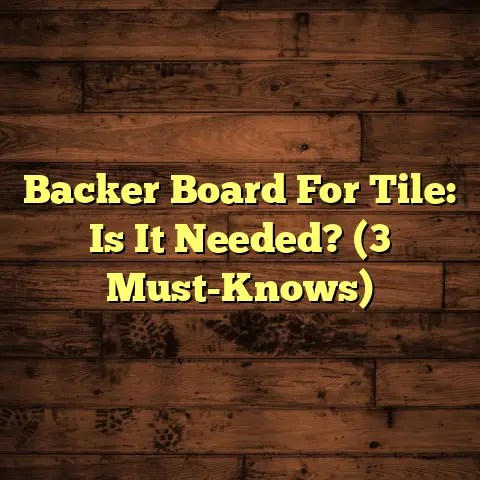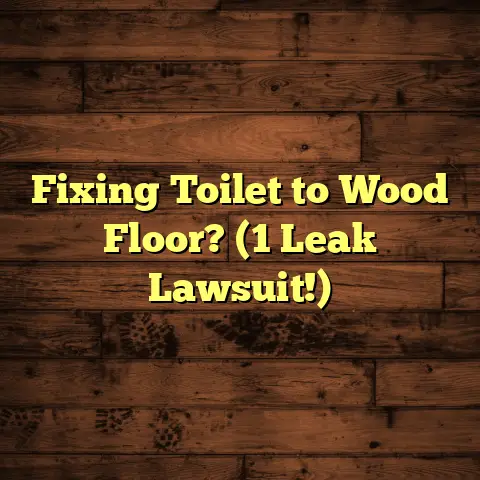Bleach For Floor Cleaning? (Never Do THIS!)
(Never Do THIS!)
Remember that feeling when you walk into your home after a long day? You just want to relax, right? But what if your floors look like they’ve been through a war zone?
I’ve seen it all as a flooring contractor: muddy footprints after a rainy week, sticky spills from kids’ birthday parties, and just that general dullness that comes after a long winter.
Homeowners often feel defeated, staring down at those floors, wondering how to bring them back to life. They want that sparkling, clean look, the kind that makes you feel good about your home. I get it.
That’s when the idea of bleach starts to creep in. It’s like this tempting shortcut, promising to blast away stains and disinfect everything in sight. The thought of those gleaming floors is so appealing. I understand the draw!
But hold on a second. Before you reach for that bottle of bleach, let’s talk about why it’s almost always a really bad idea for your floors. Trust me, I’ve seen the damage firsthand, and it’s not pretty.
Understanding Bleach:
The Good, The Bad, and The Stinky
Okay, so what is bleach anyway? Chemically speaking, it’s usually a solution of sodium hypochlorite (NaClO) in water. Think of it as a powerful oxidizing agent.
Basically, it works by breaking down the chemical bonds in stains and germs, effectively “bleaching” them away. That’s why it’s so effective at disinfecting and whitening.
Bleach is a common household staple. We use it in laundry to brighten whites, in bathrooms to kill mold and mildew, and sometimes even in the kitchen to sanitize surfaces. It’s powerful stuff!
But here’s the thing: just because it’s common doesn’t mean it’s harmless, especially when it comes to your floors. I’ve talked to chemists who’ve said that bleach is a “necessary evil” in some situations, but never for routine floor cleaning.
The Allure of Bleach
Why Are We So Tempted?
So why do homeowners even consider using bleach on their floors? Well, the immediate visual impact is a big factor. You see a tough stain, you apply bleach, and poof, it’s gone!
That instant gratification is powerful. It feels like you’ve conquered the grime and restored your floor to its former glory. Plus, the disinfecting properties of bleach give you this false sense of security. You think, “Okay, I’m not just cleaning, I’m also killing germs!”
I remember one homeowner who called me after using bleach on her laminate floors. She was thrilled at first. “My floors looked brand new!” she said. But within a few weeks, she noticed the laminate was fading and starting to peel.
Another client used bleach on her tile grout, and while it initially looked brighter, the grout started crumbling away after a few months. She was so frustrated because she thought she was doing the right thing.
The temptation is real, I get it. The promise of a sparkling clean and germ-free floor is hard to resist. But the potential consequences? They’re just not worth it.
The Risks of Using Bleach on Floors
Where Things Go Wrong (And They Will)
Okay, let’s get down to the nitty-gritty. Here’s why using bleach on your floors is almost always a recipe for disaster.
1. Damage to Flooring Materials
This is the big one. Bleach can react negatively with so many different flooring types.
-
Hardwood: Bleach is a nightmare for hardwood. It can strip away the finish, causing discoloration and even warping. Hardwood is porous, meaning it can absorb the bleach, leading to long- term damage. I’ve seen beautiful hardwood floors ruined by a single bleach application.
-
Laminate: Laminate flooring is basically a photographic image of wood or stone covered by a protective layer. Bleach can fade that image and damage the protective layer, making the floor more susceptible to scratches and stains. It can also cause the layers of the laminate to separate.
-
Tile: You might think tile is invincible, but bleach can still cause problems. It can discolor the grout, making it look uneven and patchy. In some cases, it can even erode the grout over time, leading to loose tiles.
-
Vinyl: Vinyl is more resistant to bleach than some other materials, but it’s still not a good idea. Bleach can fade the color of vinyl flooring and make it brittle over time.
I once had to replace an entire kitchen floor because the homeowner used bleach to clean up a spill on their vinyl. The bleach discolored the vinyl so badly that it looked like a Jackson Pollock painting gone wrong.
2. Health Hazards
Beyond the damage to your floors, bleach poses some serious health risks.
-
Respiratory Issues: Bleach fumes are irritating to the respiratory system. Inhaling them can cause coughing, wheezing, and shortness of breath. People with asthma or other respiratory conditions are especially vulnerable.
-
Skin Irritation: Direct contact with bleach can cause skin irritation, redness, and even chemical burns. Always wear gloves when handling bleach, and avoid getting it on your skin.
-
Chemical Burns: In concentrated form, bleach can cause serious chemical burns. If you get bleach on your skin, rinse it off immediately with plenty of water.
According to the CDC, bleach exposure can lead to a range of health problems, from mild irritation to severe burns. It’s just not worth the risk!
3. Environmental Impact
Bleach isn’t just bad for your floors and your health; it’s also bad for the environment.
-
Water Pollution: When you rinse bleach down the drain, it ends up in our waterways. Bleach can harm aquatic life and disrupt ecosystems.
-
Harmful Byproducts: When bleach mixes with other chemicals, it can create harmful byproducts, such as chlorine gas. This is why you should never mix bleach with ammonia or other cleaning products.
There are so many safer and more eco- friendly cleaning alternatives available. Why risk polluting our planet with bleach?
4. Long-term Costs vs. Short-term Gains
Okay, let’s talk money. You might think bleach is a cheap and easy way to clean your floors, but in the long run, it can end up costing you a lot more.
-
Repair Costs: If bleach damages your floors, you’ll have to pay for repairs. This could involve refinishing hardwood, replacing laminate planks, or re-grouting tile.
-
Replacement Costs: In severe cases, you might have to replace your entire floor. This is a major expense that can easily run into the thousands of dollars.
-
Health Costs: If you experience health problems from bleach exposure, you might have to pay for medical treatment. This could include doctor’s visits, medications, or even hospitalization.
I’ve seen homeowners spend way more money repairing or replacing floors damaged by bleach than they would have spent on safer cleaning products in the first place. It’s a classic case of being penny-wise and pound-foolish.
Alternatives to Bleach
Safe and Effective Cleaning Solutions
Alright, so we’ve established that bleach is a no-go for floor cleaning. But what are the alternatives? Don’t worry, there are plenty of safe and effective ways to keep your floors clean and sparkling.
-
Vinegar: Vinegar is a natural disinfectant and deodorizer. Mix equal parts vinegar and water in a spray bottle, and use it to clean most types of floors. Just be careful with hardwood, as vinegar can damage the finish over time.
-
Baking Soda: Baking soda is a mild abrasive that can help remove tough stains. Make a paste of baking soda and water, apply it to the stain, and let it sit for a few minutes before wiping it away.
-
Essential Oils: Essential oils can add a pleasant fragrance to your cleaning solution and provide additional disinfecting properties. Try adding a few drops of tea tree oil, lavender oil, or lemon oil to your vinegar and water solution.
Here are a couple of simple recipes for homemade floor cleaners:
-
All-Purpose Floor Cleaner:
- 1/2 cup white vinegar
- 1 gallon warm water
- A few drops of essential oil (optional)
-
Tough Stain Remover:
- 1/4 cup baking soda
- 1/4 cup water
- Mix into a paste and apply to stain.
The best part about these alternatives? They’re safe for your pets, your children, and the environment. Plus, they won’t damage your floors!
Conclusion
Embrace Safer Cleaning Methods
So, we’ve come full circle. We started with the frustration of dirty floors and the temptation of bleach as a quick fix. But we’ve learned that the potential downsides of bleach far outweigh the benefits.
While bleach might seem like a powerful cleaning agent, it’s ultimately a destructive force when it comes to your floors. It can damage flooring materials, pose health hazards, harm the environment, and end up costing you a lot of money in the long run.
Instead of reaching for the bleach, I encourage you to embrace safer, more effective cleaning solutions. Vinegar, baking soda, and essential oils are all great alternatives that can keep your floors clean and sparkling without risking damage or health problems.
Take pride in your home by choosing cleaning solutions that protect both your flooring and your health. You’ll be glad you did!





